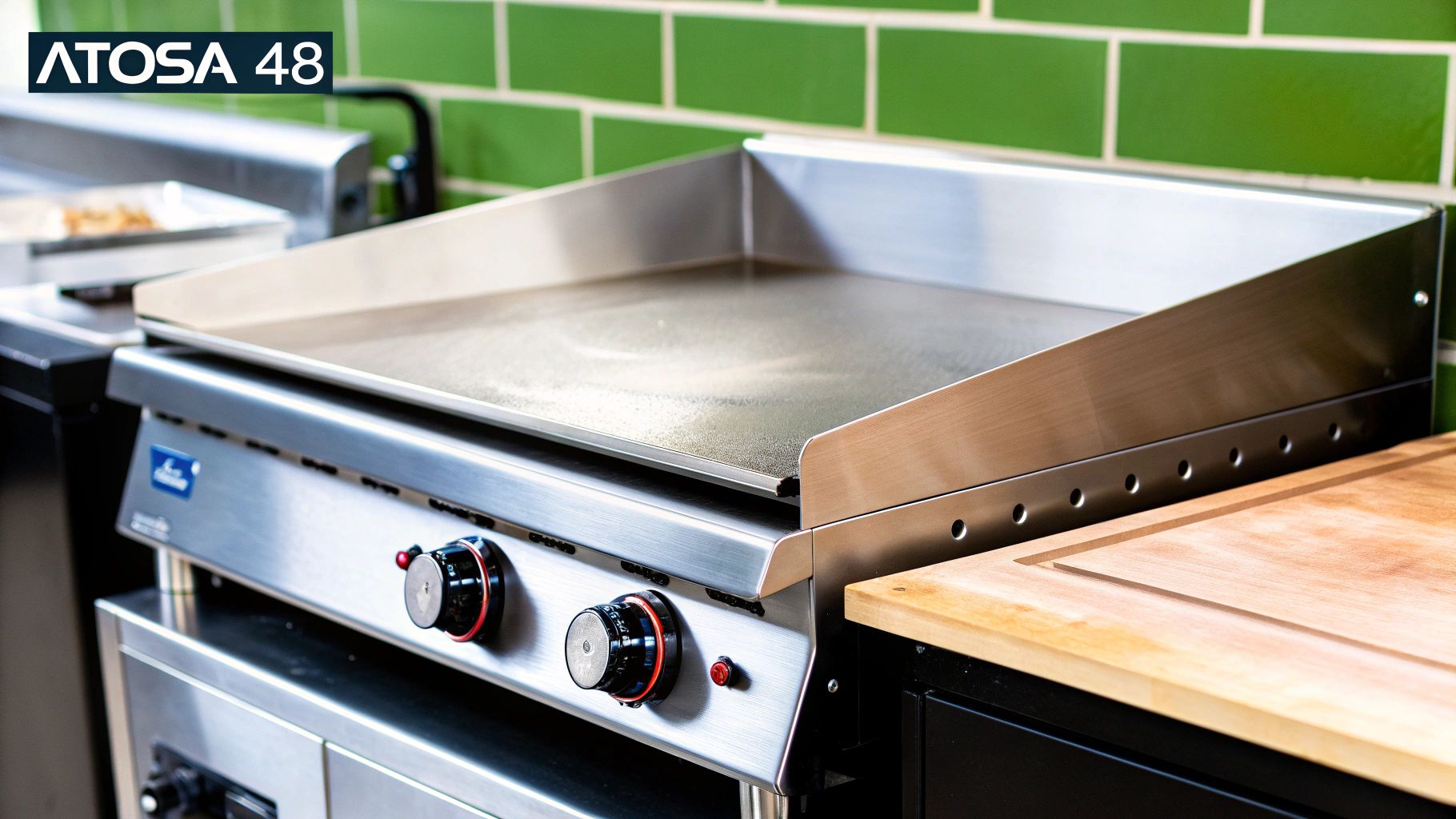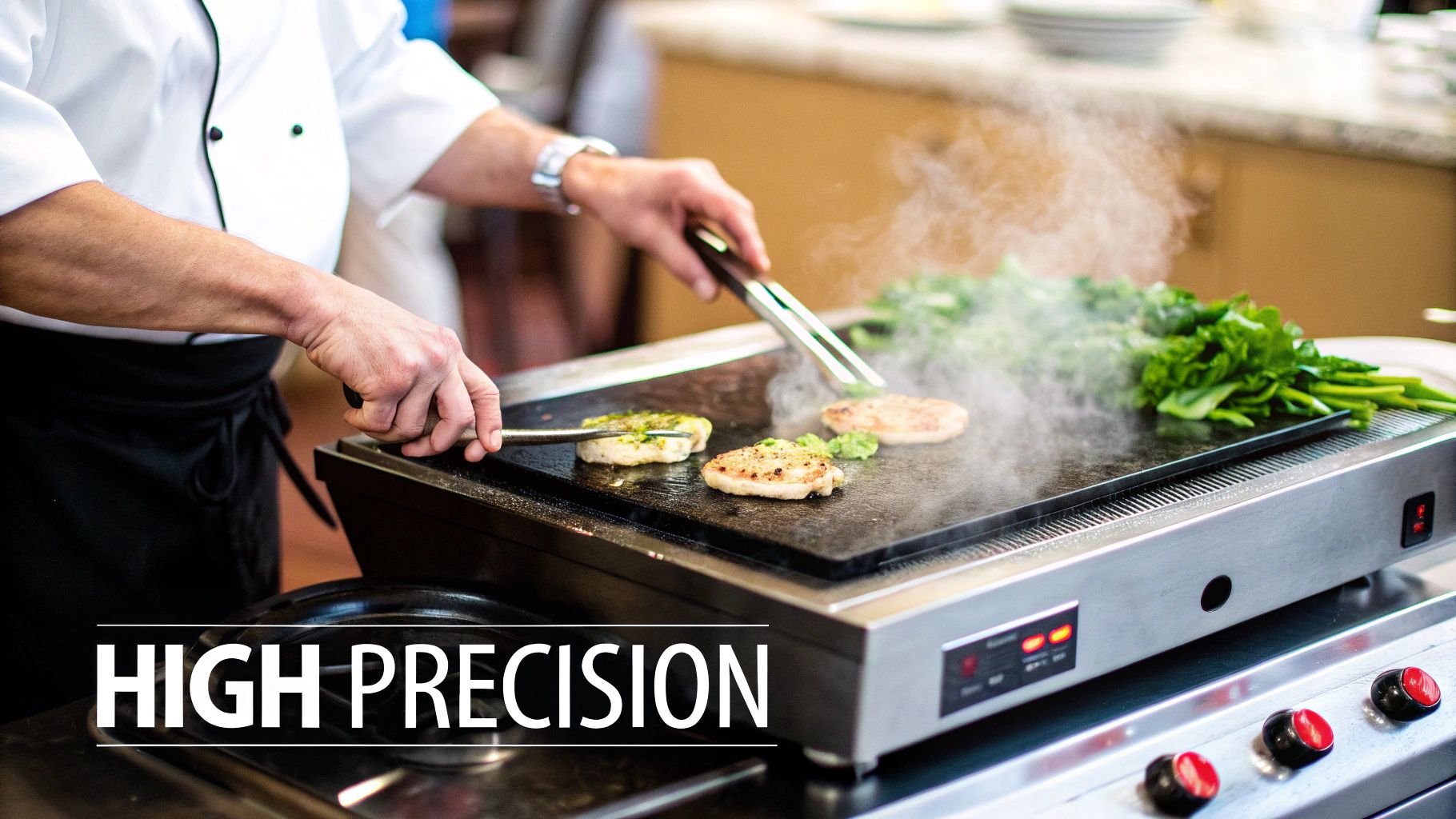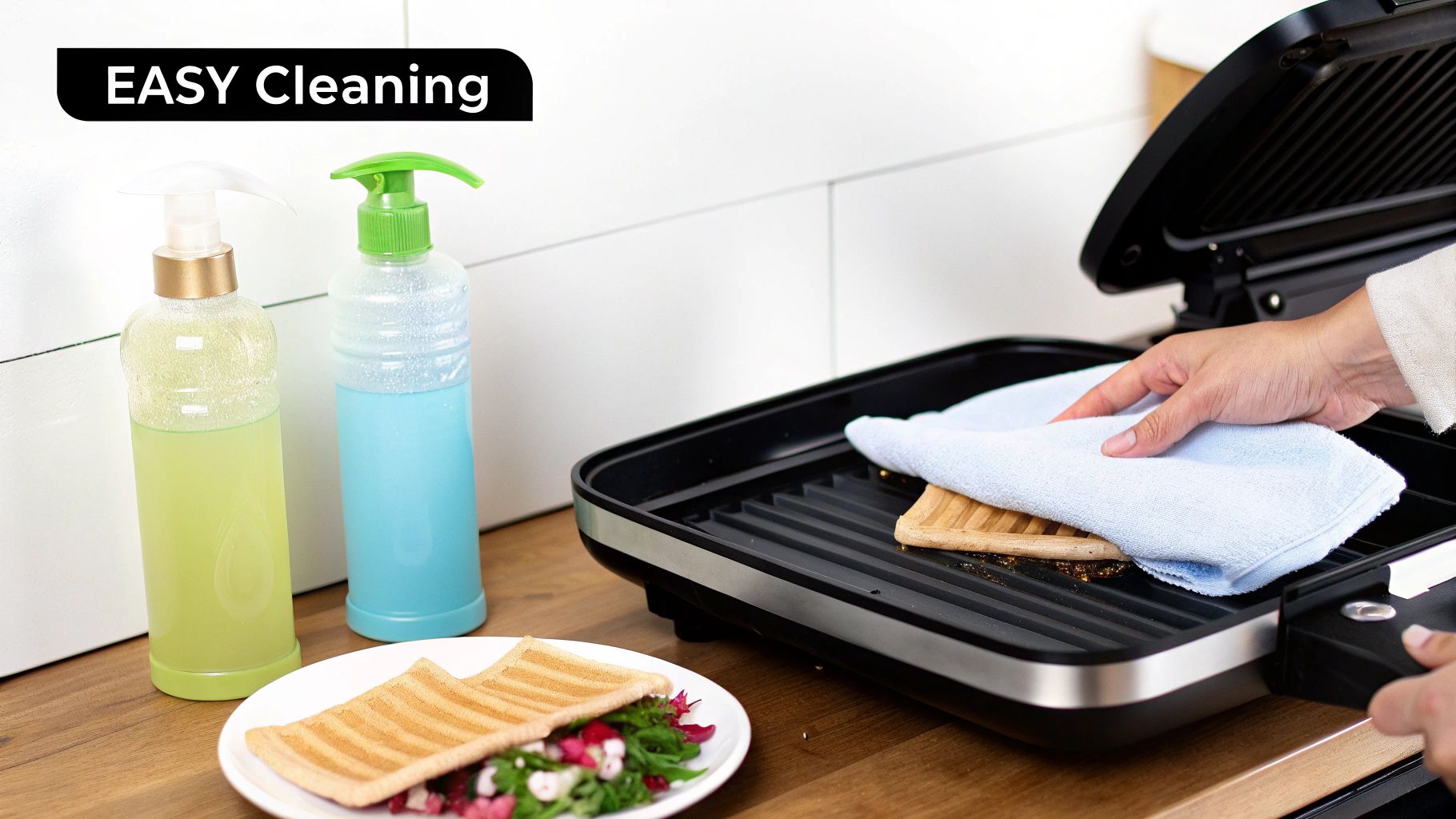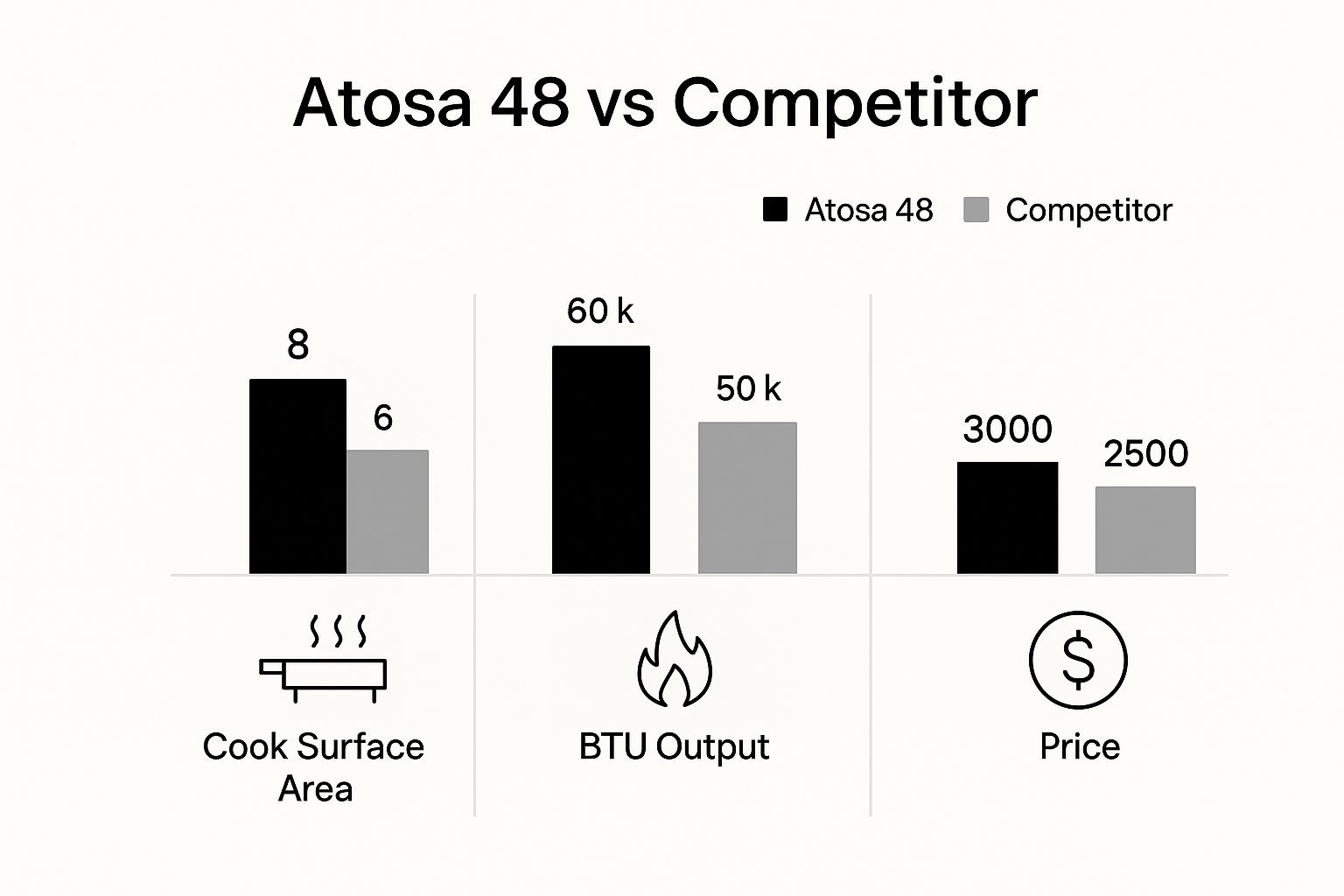
Atosa 48 Griddle: A Commercial Kitchen Workhorse
Walk onto just about any busy cook line, and you'll probably spot a workhorse like the Atosa 48 griddle holding down the fort. This heavy-duty gas griddle is the backbone of countless restaurants, diners, and food trucks, blending raw power and consistent heat with a construction that’s clearly built to last. It's the kind of equipment that keeps a professional kitchen humming, shift after shift.
Why the Atosa 48 Griddle Is a Staple in Top Kitchens
In the chaos of a commercial kitchen, the last thing you need is equipment that can't keep up. Failure just isn't an option. Chefs and owners need tools that are not only powerful but, more importantly, dead reliable. The Atosa 48 griddle was designed from the ground up to be that tool, serving as the solid foundation for so many successful kitchens. Think of it as the central command of your hot line—a versatile flattop ready for anything from delicate pancakes to a hard sear on a steak.
Its reputation comes from one simple thing: delivering consistent results under relentless pressure. This is a commercial unit built for the marathon, not a quick sprint. It’s engineered to take the abuse of back-to-back tickets without even flinching.
Built for the Grind: Performance and Durability
The real genius of the Atosa 48 griddle is in its simple, no-nonsense design. It nails the fundamentals that every professional chef cares about.
- Serious Heat Output: With a seriously impressive BTU rating, this griddle gets hot fast and stays hot, even when you're loading it up with cold food. That means faster cook times and food that comes out right every time.
- Rock-Solid Heat Retention: The griddle plate is a thick slab of polished steel. It acts like a thermal battery, soaking up heat and spreading it evenly across the entire surface. No more of those frustrating hot and cold spots that ruin a perfect sear.
- Tough as Nails Construction: The body is all stainless steel, built to resist the rust, dings, and spills that are just a part of professional kitchen life. This isn't a short-term purchase; it's a long-term asset.
This commitment to the basics is exactly why so many kitchens swear by it. It’s a piece of gear that works just as hard as the crew running it. To get a better sense of what makes the brand a solid pick, check out our guide on the Atosa griddle for more details.
The true value of the Atosa 48 griddle is its straightforward reliability. It doesn’t mess around with flashy, complicated features. It just gives you powerful, even heat every single time you turn it on—and that’s precisely what a busy kitchen needs to thrive.
At the end of the day, picking this griddle is an investment in your kitchen’s stability. It’s the peace of mind you get from knowing your most important cooking surface won't tap out during the middle of a Saturday night rush. It’s more than just a purchase; it's a smart move to keep your kitchen efficient and profitable for years.
Decoding the Specs and Core Features

When you're looking at a piece of commercial equipment like the Atosa 48 griddle, the spec sheet can feel a little abstract. But those numbers are the DNA of the machine, dictating exactly how it will perform when the ticket machine is spitting out orders. Let's translate that technical jargon into what it actually means for your kitchen.
The real headline here is the raw power. A model like the Atosa USA ATMG-48 cranks out a massive 156,000 BTUs. That isn't just a big number for bragging rights; it's the engine that drives rapid heat-up and even faster recovery.
This power is split across four independent burners, each pushing out 30,000 BTUs. This means you can load up the entire griddle with cold proteins and it snaps right back to temperature. Less waiting, more cooking. That's a huge win during a chaotic lunch rush.
To give you a better sense of the numbers behind the performance, here’s a quick breakdown of what makes the Atosa ATMG-48 such a workhorse.
Atosa 48 Griddle Model ATMG-48 Key Specifications
| Specification | Detail |
|---|---|
| Total BTU Output | 156,000 BTU/hr |
| Number of Burners | 4 (U-shaped for even heat) |
| BTU Per Burner | 30,000 BTU/hr |
| Cooking Surface | 48" W x 20" D |
| Griddle Plate Thickness | 3/4-inch (polished steel) |
| Construction | Stainless Steel (front, sides, splash guards) |
| Controls | Manual or Thermostatic |
| Fuel Type | Natural Gas or Propane (conversion kit included) |
These specs paint a clear picture: this is a machine built for volume, consistency, and durability in a professional setting.
The Secret to a Perfect Sear
Power is one thing, but control is another. The real magic of the Atosa 48 griddle lies in its heavy-duty griddle plate. We're talking about a solid 3/4-inch to 1-inch thick slab of polished steel.
Think of this plate like a cast-iron skillet, but on a massive scale. It acts as a thermal battery, soaking up all that heat from the burners and distributing it evenly across every square inch of the cooking surface. This completely eliminates the annoying hot and cold spots that can ruin a service on lesser griddles.
This incredible heat retention means you get predictable results every time. Whether you're laying down a dozen burger patties or flipping delicate crepes, the temperature is consistent. You won't have to play "shuffle the food" to find a sweet spot—the entire 48-inch surface is the sweet spot.
The thick steel plate is the griddle’s unsung hero. It’s what transforms high BTU output into controlled, even heat, giving chefs the confidence to execute their menu with precision.
It’s also worth noting the full stainless steel construction. This isn't just for a clean, professional look. In the demanding environment of a commercial kitchen, stainless steel is king. It stands up to relentless use, fights off corrosion, and makes the end-of-night cleanup a whole lot easier.
Manual vs. Thermostatic: What's Your Cooking Style?
Atosa gives you a choice between two control types, and picking the right one comes down to your menu and your team's experience.
- Manual Controls: These are the classic, no-nonsense knobs—low, medium, high. They are incredibly tough and give seasoned chefs direct control over the flame. If you're a cook who works by feel and sound, or you're doing a lot of high-heat searing, manual is your best friend.
- Thermostatic Controls: For kitchens that demand absolute precision, thermostatic controls are the way to go. You set an exact temperature, and the griddle cycles the burners to hold it there. This is perfect for delicate items like eggs and ensures that every cook on your line produces the exact same result.
You’ll also need to decide on your fuel source. These griddles can be configured for either natural gas or propane. Each has its own infrastructure needs and cost benefits. If you're weighing the options, our breakdown of natural gas vs propane for commercial equipment can help you make the right call for your setup.
The Atosa Advantage: Reliability and Return on Investment
Impressive specs and thick steel plates are great on paper, but the real test of a commercial griddle happens over thousands of hours on the line. This is where the Atosa 48 griddle really proves its worth, earning its spot in busy kitchens through pure, simple dependability. Think of it as an investment in consistency—one designed to pay you back by just showing up and getting the job done, day after day.
For any restaurant, downtime is the ultimate profit killer. A griddle going down during the lunch rush isn't just a headache; it's lost sales and a hit to your reputation. Atosa built its brand by engineering equipment that tackles this problem head-on, making reliability a core feature, not just a bonus.
Engineered for the Long Haul
Atosa has been in the game for a while, carving out a reputation for building cost-effective, tough-as-nails equipment. Since they started back in the 1990s, they've become a global name in the foodservice industry, and the Atosa 48 griddle is a perfect example of why. Its stainless steel construction and a seriously thick griddle plate—anywhere from 3/4 to 1 inch depending on the model—give it an operational lifespan that often tops 10 years. That's a lot longer than you'll get from many of its competitors. You can read more about the durability of Atosa equipment on RestaurantCity.com.
This longevity directly impacts your bottom line, lowering the total cost of ownership. The sticker price is one thing, but the real cost includes repairs, how often you have to replace it, and the money you lose when it breaks down. The Atosa griddle’s design is all about simple, robust parts that don't fail easily, ensuring it stays a workhorse in your kitchen for years.
Certified for Safety and Sanitation
One of the most critical things to check on any piece of commercial equipment is its certifications. It's not the most exciting topic, but it's non-negotiable. The Atosa 48 griddle comes with the essential credentials that health departments require, ensuring your kitchen is up to code.
These aren't just suggestions; they're your ticket to operating legally and safely.
Here are the two big ones you'll find on this griddle:
- ETL Listed: This seal means the griddle has been independently tested to meet major product safety standards. It’s your assurance that the electrical and gas components are built correctly, protecting your staff and your building.
- ETL Sanitation: Sometimes shown as "ETL-S," this mark confirms the equipment meets hygiene standards, like those from NSF. It means the materials are non-porous, the unit is easy to clean, and it’s designed to prevent food contamination.
These certifications are all about peace of mind. They guarantee the Atosa 48 griddle isn't just built to last, but also built to operate safely within the strict rules of a professional kitchen.
Picking a griddle with these certifications is a fundamental step in setting up a compliant kitchen. Atosa's commitment to meeting these standards shows they're serious about making true professional-grade equipment. It’s one more reason your investment is sound, secure, and ready for any health inspection.
Mastering Your Menu with the Atosa 48 Griddle

The real test of any commercial griddle isn't found on a spec sheet—it’s how it holds up when the ticket machine won't stop spitting and the kitchen is slammed. This is where the Atosa 48 griddle proves its worth, transforming from a simple piece of stainless steel into the workhorse of the cook line. Its true value shines brightest in the controlled chaos of a busy service.
Picture the morning breakfast rush. With four independent burners, that griddle becomes your multi-tasking command center. You can set one zone to a low, gentle heat for holding fluffy scrambled eggs and cooking pancakes without burning them. Right next to it, another zone can be cranked up high, delivering that satisfying sizzle for perfectly crisp bacon. That’s zone cooking in action.
Instead of juggling a half-dozen pans or waiting for one surface to cool down or heat up, the Atosa 48 lets you cook everything at once, uninterrupted. This alone can slash ticket times, a critical advantage when you’ve got a line of hungry customers out the door.
From Breakfast Sizzles to Lunch Service Searing
When the clock strikes noon and the menu flips to lunch, the griddle’s versatility really stands out. The same surface that gently handled delicate eggs just an hour ago can now become a high-temperature searing station for burgers and steaks.
Let’s look at how a high-volume burger joint would put it to work:
- Zone 1 (High Heat): This is your sear zone. Burger patties hit the hot steel, creating that deep, flavorful crust thanks to a powerful Maillard reaction. The griddle’s 120,000 BTU output ensures it recovers heat almost instantly, even when you load it up.
- Zone 2 (Medium Heat): Right next to the searing burgers, you can sauté onions and mushrooms, bringing out their natural sweetness without charring them.
- Zone 3 (Low Heat): This cooler spot is perfect for melting cheese over the patties or gently toasting buns to a beautiful golden-brown, keeping them soft and warm.
This kind of workflow is incredibly efficient. One cook can manage every component of an order in a single, consolidated space. It minimizes wasted steps and maximizes output. Suddenly, the Atosa 48 griddle isn't just an appliance; it's the central hub of your entire line.
The griddle's independent temperature zones empower chefs to think strategically. It’s not just a flat surface; it's four distinct cooking stations that work together to streamline service and elevate the final product.
Achieving the Perfect Maillard Reaction
That incredible, savory flavor you get on a perfectly seared steak or burger? That's the Maillard reaction—a beautiful chemical process that happens when proteins and sugars meet high heat. Getting it right requires consistent, powerful temperatures, and that's exactly what the Atosa 48 griddle is built to deliver.
To get that coveted deep-brown crust, a chef can dedicate one or two burners to a high-heat setting. The thick, ¾-inch polished steel plate is a beast at retaining energy, so when a cold steak hits the surface, the temperature doesn't plummet. This is key. It prevents the steak from steaming in its own juices and instead creates the rich, complex flavor that keeps customers coming back. The griddle becomes a true partner in the kitchen, helping you turn simple ingredients into something truly memorable.
Keeping Your Atosa 48 in Top Shape

A well-cared-for Atosa 48 griddle is the heart of a productive kitchen. If you neglect it, you're essentially running a delivery truck without ever changing the oil—sooner or later, it’s going to break down. Consistent care isn't just about protecting your investment; it's about food safety and keeping your line moving without a hitch.
The secret to a griddle that lasts for years isn't marathon cleaning sessions. It's all about building simple, routine habits. By breaking down the work into daily, weekly, and monthly tasks, you stay ahead of the grease and grime, preventing the kind of buildup that kills performance.
The Daily Shutdown Routine
At the end of every shift, a quick cleanup is non-negotiable. This simple routine stops old food bits from carbonizing on the surface, which can ruin the flavor of your next dish and mess with heat distribution. It only takes a few minutes but makes a world of difference.
Here’s what you need to do every single day:
- Scrape It Down: While the griddle is still warm (but not blazing hot), grab a griddle scraper and get to work. Push all the leftover grease and food debris right into the grease trap.
- Empty the Grease Drawer: Carefully slide out the grease drawer and empty it. This is a huge fire safety step and also prevents nasty overflows during your next busy service.
- Wipe Down the Exterior: Use a clean, damp cloth and a bit of mild soap to wipe down all the stainless steel surfaces—the front, sides, and backsplash. It keeps the unit looking sharp and professional.
This daily reset gets your Atosa 48 ready for another day of peak performance. It's a critical part of a proper kitchen closing procedure.
Why Seasoning Your Griddle Is So Important
If you do one thing for your commercial griddle, make it seasoning. Think of it as creating your own high-performance, non-stick surface. A well-seasoned griddle plate stops food from sticking, makes cleaning a breeze, and protects the steel from rust.
The whole idea is to bake a thin layer of cooking oil onto the hot griddle plate, letting it polymerize into a hard, slick coating. This surface just gets better and better the more you use it. For a full tutorial, check out our guide on how to season a new griddle.
A properly seasoned Atosa 48 isn’t a one-and-done deal. It’s a continuous process that builds an incredible, low-stick cooking surface, making life on the line easier and your results more consistent.
Don't forget the deeper checks, either. Once a month, you should be inspecting the gas lines and making sure the burner ports are free of any debris. This kind of preventative maintenance helps you catch small problems before they turn into big ones, saving you from expensive downtime and keeping your griddle running safely.
Choosing the Right Atosa 48 Griddle Model
Picking the right Atosa 48 griddle isn't about finding the "best" one—it's about matching the machine to your kitchen's rhythm. The most critical decision you'll face is the control type: manual or thermostatic. This single choice shapes everything from your cooking process and menu consistency to how you train your line cooks.
Manual Controls: The Hands-On Workhorse
Think of a manual griddle as the classic, no-frills option. It’s all about feel. You get simple low, medium, and high settings, giving a seasoned chef direct, hands-on control over the heat. This is perfect for the cook who knows their craft, listening for the sizzle and watching the color to get that perfect, hard sear on a smash burger or steak.
Models like the ATMG-48 are built tough. Fewer complex electronics mean fewer things can break, making them incredibly reliable for high-volume kitchens that value simplicity and a lower initial price tag. If your menu is all about high-heat cooking and you have an experienced team, a manual griddle is a true workhorse that won't let you down.
Thermostatic Controls: The Key to Consistency
Now, let's talk about thermostatic controls. This is where precision takes center stage. Instead of a general heat level, you dial in an exact temperature—say, 350°F. The griddle's internal thermostat then does the work, automatically cycling the burners to hold that temperature steady.
This kind of accuracy is a lifesaver for kitchens dealing with more delicate foods. It means every pancake comes out perfectly golden, and you never have to worry about accidentally overcooking expensive scallops. More importantly, it brings consistency to your entire kitchen.
With a thermostatic griddle, you eliminate the guesswork. A new hire can be trained to set the dial to the right temperature and achieve the exact same result as your head chef. That's how you protect your menu's quality, no matter who's on the line.
This makes training new staff a breeze and standardizes your recipes. While thermostatic models like the ATTG-48 have a higher upfront cost, they pay you back in reduced food waste and rock-solid product quality.
To make the choice even clearer, let's put the two control types side-by-side.
Manual vs. Thermostatic Controls on the Atosa 48 Griddle
Choosing between manual and thermostatic controls really comes down to your operational priorities—speed and feel versus precision and consistency. This table breaks down what you can expect from each.
| Feature | Manual Controls (e.g., ATMG-48) | Thermostatic Controls (e.g., ATTG-48) |
|---|---|---|
| Precision | Less precise; works on low, medium, and high settings. | Highly precise; holds a specific, set temperature. |
| Ideal Use Case | High-heat searing, experienced chefs, simple menus. | Delicate foods, menu consistency, kitchens with varied staff skill levels. |
| Training | Takes more experience to master heat management by feel. | Simple to train new staff for consistent, repeatable results. |
| Cost | Usually a lower upfront cost due to simpler mechanics. | Higher initial investment for the more advanced technology. |
| Best For | Diners, burger joints, and kitchens focused on raw power and speed. | Restaurants with diverse menus, cafes, and institutional kitchens. |
In the end, it’s a simple trade-off. If your kitchen runs on the skill of experienced chefs and a menu that calls for high heat, the simplicity of a manual griddle is a fantastic value. But if your success depends on absolute consistency and a menu that demands careful temperature control, investing in a thermostatic Atosa 48 griddle will pay for itself over and over again.
Frequently Asked Questions About Atosa Griddles
When you're shopping for a new commercial griddle, you've got questions. We've got answers. Let's tackle some of the most common things people ask about the Atosa 48 griddle.
A big one is always about power and heat consistency. Nobody wants a griddle with pesky hot spots that burn one pancake while leaving another raw. The Atosa ATTG-48 packs a serious punch with 100,000 BTUs of total power, spread evenly across four independent burners.
Each 12-inch section gets its own dedicated 25,000 BTUs, giving you precise control over your cooking surface. Combine that with a seriously thick 1-inch steel plate, and you get incredibly even heat distribution and retention. You can dive deeper into how these specs make a difference for commercial gas griddles over at ChefsDeal.com.
Still weighing your options? This chart breaks down how the Atosa 48 stacks up against a typical competitor.

As you can see, the Atosa 48 brings more cooking real estate and a higher BTU output to the table, making it a workhorse for any busy kitchen.
Ready to see what an Atosa can do for your line? Check out the full lineup and find the right fit for your restaurant at Griddles.com.
